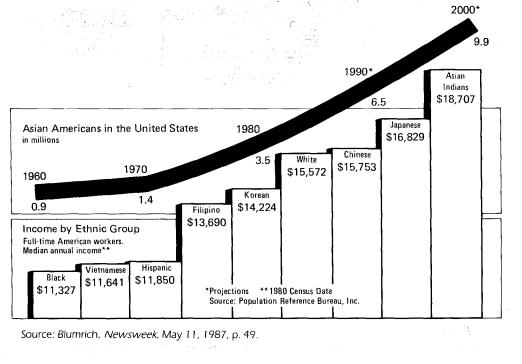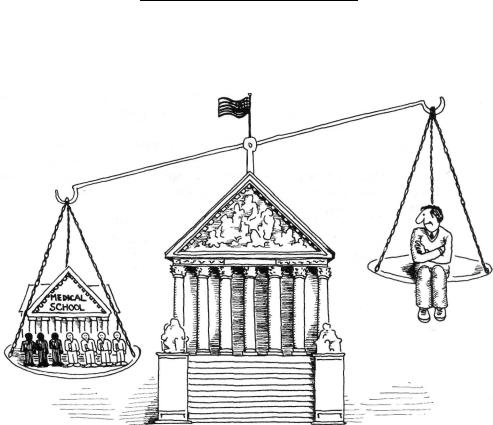
contactusa
.pdf
section 2
Look Again
A. Vocabulary
DIRECTIONS: Circle the letter of the choice that best completes each sentence.
1. I love to eat; |
|
, I hate to cook. |
|
|
|
|
|||||||||
|
a. ironically |
|
|
|
b. naturally |
с |
financially |
||||||||
2. |
One |
|
of city living is the high cost. |
|
|
||||||||||
|
|
|
|
|
|
|
|
|
|
|
|
|
|
||
|
a. advantage |
|
|
b. benefit |
|
|
с |
disadvantage |
|||||||
3. |
He was |
|
|
|
from the club because of his religious beliefs. |
||||||||||
|
|
|
|
|
|
|
|
|
|
||||||
|
a. participated |
|
|
b. excluded |
c. designated |
||||||||||
4. Whites in the United States are the________ |
|
|
|||||||||||||
|
a. minority |
|
|
b. majority |
с |
newcomers |
|||||||||
5. |
The cruel |
|
|
|
|
of slaves in the United States is difficult to believe. |
|||||||||
|
|
|
|
|
|
|
|
|
|
|
|||||
|
a. treatment |
|
|
b. protection |
с |
heritage |
|||||||||
6. |
Although she didn't like him, he |
|
in calling her. |
|
|
||||||||||
|
|
|
|
|
|
|
|
|
|
||||||
|
a. associated |
|
|
b. persisted |
с |
designated |
|||||||||
7. |
Busing is a(n) |
|
to equalize educational opportunities. |
|
|||||||||||
|
a. loss |
|
|
|
|
|
|
b. attempt |
с |
participation |
|||||
8.public schools are not legal.
a. Integrated |
b. Associated |
с |
Segregated |
||
9. He is |
to teach economics. |
|
|
||
|
|
|
|
|
|
a. adequate |
b. qualified |
с |
obvious |
||
10.discrimination is clear and easy to see.
a. Reverse |
b. Blatant |
с Unjust |
152

В.Reading Comprehension
1.Compare blacks to other groups who came to the U.S. Give two ex amples of disadvantages which they had.
2.Give two examples of discrimination against blacks.
3.Reread the information about equality in education and try to explain what busing means.
4.Affirmative action means that organizations try to fill jobs with mi norities. Why do you think people should do this?
C.Think About It
1.Is there discrimination in your country? Is it racial? Social? Or sex ual? What kind of discrimination takes place? Employment? Hous ing? Education?
D.Reading
DIRECTIONS: Study the following graph and answer the questions below.
Look Again |
153 |

The two graphs shown above are from an article about Asian Americans.
1.a. What does the "Asian Americans in the United States" graph measure?
b.For how many years?
2.a. What does "Income by Ethnic Group" measure?
b.Which ethnic group earns the most?
сWhich ethnic group earns the least?
d.What is the dollar difference between the highest earning Asian group and the lowest earning Asian group?
e.How do Hispanics compare to the other ethnic groups?
f.What reasons can you think of to explain the differences in income?
154 Racial Issues

section 3
Contact a Point of View
A. Background Building
The affirmative action policies are difficult to understand. These policies suggest each organization should reflect the total population. For example, blacks make up about 15 percent of the population in the United States. If you own a small company with 100 employees, how many should be black?
B. Timed Reading
In the early 1970s, Allen Bakke, an engineer from California, decided that he wanted to change his career and become a doctor. He applied to the medical school at the University of California. Bakke was a
155

good student; he had graduated from the University of Minnesota with an A average and had a master's degree from Stanford. He was not accepted by the University of California. He was very upset.
Bakke discovered that the university had an affirmative action policy; he believed that some black students who were accepted to the medical school were not as qualified as he was. In other words, he felt that they were accepted because of their race and not because of their background. It seems that the university was trying to equalize educational opportunities for minority students. The university hoped that by accepting a certain number of minority students, they could change a long history of discrimination.
Bakke felt that this affirmative action policy was unjust and that he had a right to attend medical school. He felt that he was better qualified and that the action of the medical school was reverse discrimination. He considered the action illegal and decided to bring his problem to the court for a decision.
He brought the issue to two state courts in California. The decision of the judges was that the action of the medical school was perfectly legal and that Bakke had to accept this decision.
He then decided to bring the problem to the United States Supreme Court, where the final decision-making power in the United States lies. What do you think happened?
DIRECTIONS: Read each of the following statements carefully to determine whether each is true (T), false (Fj, or impossible to know (ITK).
1.Bakke's background was better than most others.
2.Bakke had a good background.
3.Bakke applied to Stanford Medical School.
4.This case happened last year.
5.Reverse discrimination means not accepting minorities.
6.The Supreme Court makes final decisions about laws in the United States.
7.Bakke had no alternative after the decision of the two lower (state) courts.
8.The policy of the school was to fill all places with minority students.
9.The two state courts said that the action was illegal.
10.Bakke accepted the decision of the state courts.
156 Racial Issues
С. Vocabulary
DIRECTIONS: Fill in the blanks with vocabulary from the reading.
1. |
applied/accepted/attended |
|
|
|
|
|
|
|
|
|
|
|||||||||
|
Allen Bakke |
|
|
|
|
the University of Minnesota as an under |
||||||||||||||
|
|
|
|
|
|
|
|
|
|
|
|
|
|
|
|
|
|
|
|
|
|
|
graduate. He |
|
|
|
|
|
to the University of California, but was |
||||||||||||
|
|
not |
|
|
|
|
|
|
|
|
|
|
|
|
|
|||||
2. |
|
discrimination/judge/illegal |
|
|
|
|
|
|
|
|
|
|
||||||||
|
|
The |
|
considered |
that _____________________in any |
|||||||||||||||
|
|
|
|
|
|
|
|
|
|
|
|
|
|
|
|
|
||||
|
|
form was |
|
|
|
|
|
|
|
|
|
|
|
|||||||
3. |
|
applicants/accepted/backgrounds |
|
|
|
|
||||||||||||||
|
|
|
|
|
|
|
|
|
who |
|
had |
|
|
that were not as |
||||||
|
|
good as Bakke's were |
|
|
|
|
|
|
|
|
|
|
|
|
||||||
4. policy/attempt |
|
|
|
|
|
|
|
|
|
|
||||||||||
|
|
This |
|
was an |
|
|
to equalize op |
|||||||||||||
|
|
|
|
|
|
|
|
|
|
|
|
|
|
|||||||
|
|
portunities. |
|
|
|
|
|
|
|
|
|
|
||||||||
D. React
DIRECTIONS: Mr. Bakke's affirmative action case is a difficult one. According to the facts, what would you decide?
Get into groups of five and decide the case as the Supreme Court did. Remember that you must have a majority decision (3 to 2j. After reaching your decision, present it to the class. Here is some useful vocabulary.
We feel that . . . |
|
We agree that . . . |
|
Mr. Bakke should .. . |
legal/illegal |
The university should . . . |
necessary/unnecessary |
All applicants should . . . |
unconstitutional |
Minority applicants must . . . |
|
Racial discrimination . . . |
|
Reverse discrimination . . . |
|
Contact a Point of View |
157 |

Ε. Word Analysis
Part 1
DIRECTIONS: Choose the appropriate word form for each sentence. Is it a noun or a verb?
1. |
employ |
1. |
She is looking for |
|
|
|
|
|
|
|||
|
employment |
|
|
|
|
|
|
|
|
|
|
|
2. |
Discriminate |
2. |
|
|
|
|
. is unfortunately part of the |
|||||
|
Discrimination |
|
history of this country. |
|
|
|
|
|
||||
3. |
treat |
3. |
What is the best way to |
|
|
|
|
|
||||
|
treatment |
|
cold? |
|
|
|
|
|
||||
4. |
educate |
4. |
Public schools should |
|
|
|
|
every- |
||||
|
education |
|
body. |
|
|
|
|
|||||
|
|
|
|
|
|
|
||||||
5. |
protect |
5. |
Don't worry. I'll |
|
|
you. |
|
|||||
|
protection |
|
|
|
|
|
|
|
|
|
||
|
|
|
|
|
|
|
|
|
|
|
|
|
6. |
equalize |
6. |
Is the basis of democracy |
|
|
|
|
|
||||
|
equality |
|
|
|
|
|
|
|
|
|
|
|
7. |
associate . |
7. |
She denies any |
|
|
with him. |
||||||
|
association |
|
|
|
|
|
|
|
|
|
|
|
8. |
designate |
8. |
The |
|
|
|
of "white only" facilities |
|||||
|
designation |
|
is now over. |
|
|
|
|
|
||||
9. |
act |
9. |
They always |
|
|
natural. |
|
|||||
|
action |
|
|
|
|
|
|
|
|
|
|
|
10. solve |
10. |
Time isn't going to. |
|
__________this |
prob- |
|||||||
|
solution |
|
lem. |
|
|
|
|
|
||||
Part2
DIRECTIONS: In other chapters, you have studied parts of the boldfaced words in the fol lowing sentences. Write the letter with the correct meaning of the boldfaced word from the list below the sentences.
1.They asked the government to intervene because the two groups couldn't come to any agreement.
2.He walked right past me as if I were invisible.
3.All I want is an equitable solution to the problem.
4.I'm going to preview the movie I'm planning to show in class tomorrow.
158 Racial Issues

5.I read that woman's autobiography. It was quite interesting.
6.Where's the exit to this building?
7.In my judgment, the driver was wrong.
8.I think he needs psychiatric help.
9.His leg was visible sticking out from behind the sofa.
10.Exercise has beneficial effects on your body and mind. ____
a. |
look at before |
f. |
able to be seen |
b. |
opinion |
g. |
come between |
с |
fair |
h. |
way out |
d. story about your own life |
i. |
not able to be seen |
|
e. mental |
j. |
good, positive |
|
Contact a Point of View |
159 |

section 4
Look Back
A. Vocabulary
DIRECTIONS: Circle the letter of the choice that best completes each sentence.
1. The woman did not want the magazines, but the salesman was
|
a. exclusive |
b. protective |
с |
persistent |
|||||||
2. |
This paper from the state court is filled with |
|
|
|
|
|
|||||
|
a. tension |
|
b. legalities |
с |
loss |
||||||
3. |
She has everything in order: She |
|
her work very carefully. |
||||||||
|
a. segregates |
b. organizes |
с |
associates |
|||||||
4. |
She makes all the important company decisions, all the |
|
|
ones. |
|||||||
|
a. reverse |
|
b. major |
|
|
|
с |
minor |
|||
5. |
It is |
|
to do that now. Don't wait. |
|
|
|
|
|
|
||
|
a. blatant |
|
b. advantageous |
с |
succeeding |
||||||
6.speaking, I don't understand the situation at all.
|
a. |
Unjustly |
|
|
b. Continuously |
|
с |
Seriously |
||
7. |
He |
|
football with Americans. |
|
|
|
||||
|
a. associates |
|
|
b. participates |
|
с |
discriminates |
|||
8. |
Cats are very |
|
of their kittens. |
|
|
|
||||
|
a. protective |
|
|
b. serious |
с |
affirmative |
||||
9. |
He has improved 100 percent. He has made great |
|
|
|
||||||
|
a. attempts |
|
|
b. gains |
с |
losses |
||||
10. |
He has very |
|
taste; only the best for him. |
|
|
|
||||
|
|
|
|
|
|
|
|
|
||
|
a. regulatory |
|
|
b. discriminating |
|
с |
common |
|||
160
В. Matching
DIRECTIONS: Find the word or phrase in column В which has a similar mean ing to a word in column A. Write the letter of that word or phrase next to the word in column A.
|
|
A |
|
B |
1. |
naturally |
a. unfair |
||
|
|
|
|
|
2. |
disadvantage |
b. positive |
||
|
|
|
|
|
3. |
adequate |
с |
tied with |
|
|
|
|
|
|
4. |
legal |
d. |
different |
|
|
|
|
|
|
5. |
participation |
e. enough |
||
|
|
|
|
|
6. |
segregate |
f. |
easy to see |
|
|
|
|
|
|
7. |
unjust |
g. |
obviously |
|
|
|
|
|
|
8. |
qualified |
h. problem |
||
|
|
|
|
|
9. |
associated |
i. |
lawful |
|
|
|
|
|
|
10. |
blatant |
j. |
continue |
|
|
|
|
|
|
11. |
serious |
k. |
able |
|
|
|
|
|
|
12. |
majority |
1. important |
||
|
|
|
|
|
13. |
distinct |
m. larger percentage |
||
|
|
|
|
|
14. |
persist |
n. involvement |
||
|
|
|
|
|
15. |
affirmative |
o. separate |
||
|
|
|
|
|
СSynthesis Questions
1.In the 1960s, the now famous case of Rosa Parks occurred; she was a black woman who would not give up her seat on the bus and move to the back. She was then arrested. Can that happen today?
2.In many places in the world, there are all male private clubs. How do you feel about all-male clubs? Find out if these are possible in the United States.
3.The Ku Klux Klan is an anti-black organization in this country. Its members are prejudiced against blacks. Why do you think this group exists? Is this group legal in the United States?
Look Back |
161 |
